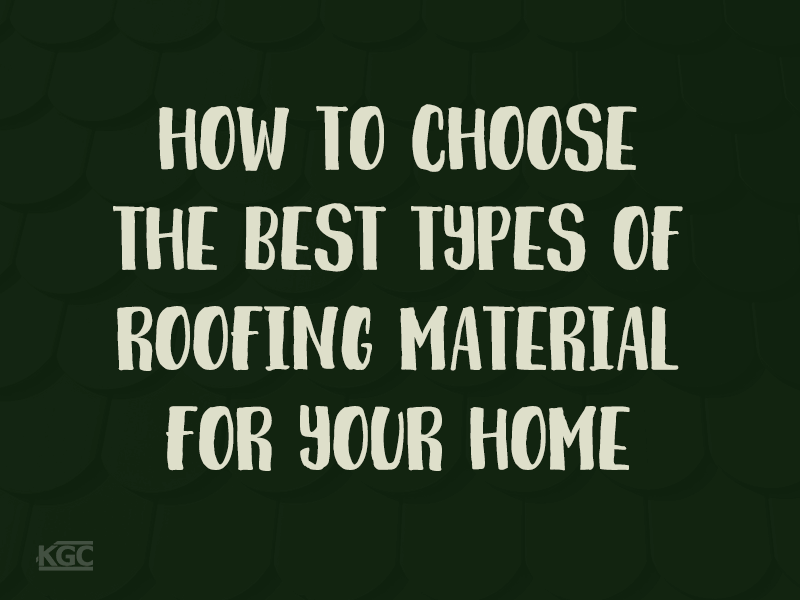Every homeowner knows the value of a durable, beautiful roof. Above and beyond protecting your home, its inhabitants, and contents, your roof can contribute enormously to the look of your home.
The roof is a big portion of the investment you make in your home but choose well and you’ll not only have durable protection over your head, you’ll also be enhancing the beauty and style of your house.
There are plenty of roof options, but with so many materials, how do you choose?
There’s a lot to consider: budget, longevity, strength, and style. Here in Oregon, with our warm summers and cold winter, durability is really important: your roof will have to withstand the wind, hail, and snow. Increasingly, people are also becoming interested in the eco-friendliness of the materials.
In this article, we break down the various types of materials in detail, their longevity, and their eco-friendliness.
Roofing materials
Metal
Metal might not be foremost on people’s minds when it comes to roofing materials, or you may immediately think of barns, but metal is increasingly becoming popular, especially for rustic-style homes.
Metal roofs have a long lifespan, and the fact that it’s lightweight and durable (you won’t need to reinforce the roof structure) makes it an interesting choice for homeowners. It’s also fire-resistant and easy to install, but you’ll need a roofer who’s comfortable working with metal roofs.
Metal roofing typically means copper, steel, or aluminum. Aluminum is very popular because it can be made to look like slate and comes in many different colors. Of the metals, copper is the most costly but its beauty and durability may offset the costs (copper turns green over time, giving the roof a very distinct look).
Metal roofs don’t typically need a lot of maintenance and can be very energy efficient. They’re also great for water catchment for keen gardeners!
In the summer, a metal roof will reflect the sun’s rays, keeping the house cool; in winter, unfortunately, metal roofs can be a bit noisy when it rains or hails (insulation can help). In Oregon, if you’re considering this roofing style, it’s wise to invest in a heated metal roof, so snow will quickly melt and just run off the roof, without piling up.
Longevity: 50-100 years
Eco-friendliness: Metal can be quite eco-friendly: metal roofs can be made entirely of recycled metal and can then, in turn, be recycled at the end of their life.
Concrete/cement tiles
Concrete or cement tiles are artificially created from sand, cement, and pigments, and can look very attractive on a house. They come in a large selection of patterns, colors, and shapes that emulate clay or slate tiles or wood shakes, making them very popular with homeowners who are keen to get a particular style.
They offer excellent protection during our long Oregon winters, as they’re naturally insulating and water resistant.
Concrete tiles can be very heavy, so you may have to reinforce your roof deck if you choose this material. This weight also plays in your favor, however, because they’re less likely to fly away during a storm or develop cracks or leaks.
Less expensive than clay tiles, concrete roof tiles can last a long time and are very fire resistant.
Longevity: around 50 years
Eco-friendliness: Natural materials, but manufacture can be taxing on the environment.
Slate
Slate comes from natural fine-grained rocks and is one of the oldest roofing materials. Unlike asphalt, the shingles won’t be as likely to crack or curl after several beatings of our Oregon winters.
Slate is a great choice for homeowners investing in a new roof. It’s one of the toughest materials that will withstand winter after winter (as long as it’s properly installed initially). Slate roofs are also fire-retarding, and extremely durable.
They can, however, be quite heavy, so your roofing company will have to reinforce the roofing support structure.
This material is one of the most expensive roofing materials, even before you add up the labor costs to upgrade the roof deck. However, with its beautiful appearance, durability, and performance (it’s extremely energy efficient), it remains one of the most popular roofing materials throughout time, and you’ll see plenty of them around Portland and Oregon.
Longevity: 100+ years
Eco-friendliness: Completely natural, sustainable.
Clay
Along with slate, clay tiles are very energy efficient and durable, and are one of the oldest roofing materials.
Clay roofing tiles are popular in the south and coastal areas of the US, and sometimes here in Oregon because they’re very durable in inclement weather. They also regulate the internal temperature of your house quite well. People also love the Spanish-style look they give their houses.
Clay tiles also include ceramic and terra cotta: clays is a natural material that’s fired in a kiln, and looks fantastic on most homes. They come in various colors, but their natural color has a beauty all its own and won’t easily fade or discolor.
As well as being quite resistant to snow and rain, clay is very fire resistant. Clay roofs will need to be reinforced to carry the weight of the tiles.
Longevity: 70+ years
Eco-friendliness: Completely natural and recyclable but requires significant energy to manufacture.
Composites
Polymer and composite roofing shingles are made of plastics, polymers, rubber, or asphalt mixtures, and look like real slate or wood. They look quite attractive on roofs and aren’t as costly as some of the other options.
These types of shingles are very durable and can withstand extreme temperatures, and they also perform very well on energy efficiency. Composites will keep your house warm in winter but also cool in summer.
You’ll see quite a few of them in Portland and Oregon. They’re easy to look after and are super durable—but while the plastic is long-lasting, it also means it’s not very sustainable or eco-friendly.
On the upside, they’re not as heavy as slate or concrete, so your roof structure likely won’t need any extra support.
Longevity: around 50 years
Eco-friendliness: Plastics, some can be recycled, but not a sustainable material. You may be able to find recycled plastic polymer shingles.
Asphalt shingles are made of fiberglass, ceramic, and asphalt grains. They’re a popular roofing option because of their affordability and style: they come in many different colors, including wood and slate lookalikes, and aren’t as expensive as other options.
Asphalt shingles aren’t very heavy, so there’s no need to reinforce the roof deck, and they’re relatively easy to install.
They’re not as durable as other roofing options: in heavy snow like what we get in Oregon, they’ll have to be inspected and maintained regularly, or you may see the odd shingle fly away during a storm or find yourself holding up a bucket to your roof (if properly maintained, you should be fine! See how to conduct a roofing inspection to keep on top of things.)
You can put chances on your side by choosing better quality (and therefore more expensive) asphalt shingles that have a good durability and impact resistance.
Longevity: around 20-30 years
Eco-friendliness: Petroleum-based product: can be but aren’t often recycled, and has to be replaced frequently.
Wood Shingles and Shakes
Wood shingles look amazing and give a special natural, “warm” look to houses, regardless of their setting. Wood shingles are really durable and made to withstand tough conditions like snow and ice. They’re very energy efficient.
Most often, they’re made of cedar wood, which offers great resistance to weather but they’re not as fireproof as other materials (but you can have them treated).
Wood shingles also require more maintenance than some other options. They’re not as heavy as slate or concrete, but not as light as asphalt or composites.
In addition, cedar wood shingles are durable alternatives that can survive countless winters and low temperatures without deteriorating in quality. They last longer than asphalt, but aren’t as durable as slate, for example. They’re prone to cracking, so you should invest in shingles with a good hail rating and keep an eye on them over the seasons.
Longevity: 30-50 years
Eco-friendliness: 100% natural product, highly sustainable.
Green or ‘living’ roofs
Green roofing isn’t just for hippies and hobbits anymore: green roofs are gaining popularity in both urban as well as rural contexts.
A green roof is a way to cover asphalt or other flat roofs with vegetation: heat radiates from the roof, and rain falls directly on it, so it’s an ideal place to grow vegetation in a neglected area. A waterproof membrane has to be installed on the roof, followed by a root barrier, drainage, and filtration layers, and then finally the soil so you can grow your plants.
If well designed, installed, and maintained, a green roof can save you money in the long term. Green roofs are great at insulating your home and reduce energy costs (they act as a built-in thermal insulator). They also absorb stormwater so you may not need complex draining systems for heavy rainfalls.
Extensive green roofs are designed to be self-sustaining, while intensive green roofs are more like a garden and will need regular maintenance. Either way, you’ll need reinforcements to your roof structure to carry the weight of your rooftop garden. They’re not for everyone (or for every roof), but you can do something very positive for your immediate environment with a green roof.
Longevity: about 40 years
Eco-friendliness: Sustainable and great for the environment, reduce air pollution, replace greenery, promote habitats.
A word about longevity and durability
Roof material longevity can vary greatly depending on quality, weather, foot traffic, installation, and maintenance. These are guidelines only.
At Keith Green Construction, we’re happy to help walk you through the options if you’re selecting a new roof. Contact us and we’ll discuss the things that matter to you and help guide you so we can find a solution that meets your needs, together.

